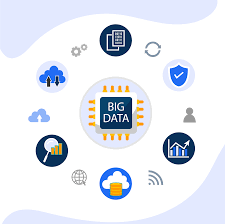In the contemporary digital age, Big Data has emerged as a transformative force, reshaping industries, influencing decision – making processes, and revolutionizing the way we understand the world. Big Data refers to extremely large and complex datasets that are characterized by the three Vs: volume, velocity, and variety. The volume implies the vast amount of data being generated every second, the velocity represents the high – speed at which data is created and processed, and the variety indicates the different types of data, including structured, semi – structured, and unstructured data. This article will explore the various aspects of Big Data, including its sources, applications, challenges, and future trends.
Sources of Big Data

Big Data is generated from a multitude of sources, each contributing to the ever – expanding pool of information.
| Source of Big Data | Description | Example |
|---|---|---|
| Social Media Platforms | These platforms generate a massive amount of data through user interactions, such as posts, likes, comments, and shares. The data is often unstructured and provides insights into user behavior, preferences, and social trends. | Facebook, Twitter |
| Internet of Things (IoT) Devices | IoT devices, such as smart sensors, wearables, and connected appliances, constantly generate data about their environment and usage. This data can be used for various purposes, including predictive maintenance and environmental monitoring. | Smart thermostats, fitness trackers |
| Transactional Systems | Businesses generate a large amount of structured data through their transactional systems, such as sales records, inventory management, and customer relationship management (CRM) systems. This data can be analyzed to improve business operations and customer service. | Point – of – sale systems, e – commerce platforms |
| Scientific Research | In the field of scientific research, large – scale experiments and observations generate Big Data. For example, in astronomy, telescopes collect vast amounts of data about celestial objects, and in genomics, DNA sequencing generates large datasets for genetic research. | CERN’s Large Hadron Collider experiments, The Human Genome Project |
Applications of Big Data

The applications of Big Data are widespread and span across multiple industries.
- Healthcare: Big Data has the potential to revolutionize healthcare. By analyzing patient data, including medical records, genetic information, and lifestyle data, healthcare providers can make more accurate diagnoses, develop personalized treatment plans, and predict disease outbreaks. For example, data analytics can be used to identify patterns in patient populations at risk of chronic diseases such as diabetes and heart disease.
- Finance: In the financial sector, Big Data is used for risk assessment, fraud detection, and investment analysis. Banks can analyze customer transaction data to detect unusual patterns that may indicate fraud. Investment firms can use Big Data analytics to analyze market trends and make informed investment decisions.
- Retail: Retailers use Big Data to understand customer behavior, optimize inventory management, and personalize marketing campaigns. By analyzing customer purchase history and browsing behavior, retailers can recommend products that are likely to be of interest to individual customers, increasing sales and customer satisfaction.
- Transportation: Big Data is also transforming the transportation industry. In logistics, data analytics can be used to optimize routes, reduce fuel consumption, and improve delivery times. In the automotive industry, connected cars generate data that can be used for predictive maintenance and autonomous driving development.
Challenges in Big Data
Despite its numerous benefits, Big Data also presents several challenges.
- Data Storage and Management: The sheer volume of Big Data requires significant storage capacity. Managing and organizing this data in a way that allows for efficient retrieval and analysis is a major challenge. Additionally, ensuring data integrity and security during storage and transfer is crucial.
- Data Quality: Big Data often contains inaccurate, incomplete, or inconsistent information. Ensuring data quality is essential for reliable analysis. Data cleaning and preprocessing techniques are required to remove errors and inconsistencies from the data.
- Data Privacy and Security: Big Data contains a wealth of personal and sensitive information. Protecting this data from unauthorized access, use, and disclosure is a top priority. There are also legal and ethical issues surrounding the collection, use, and sharing of Big Data.
Future Trends in Big Data

The future of Big Data is filled with exciting possibilities.
- Artificial Intelligence and Machine Learning Integration: The integration of Big Data with artificial intelligence (AI) and machine learning (ML) will enable more advanced data analysis. AI and ML algorithms can automatically detect patterns and trends in Big Data, making predictions and providing insights that were previously impossible to obtain.
- Edge Computing: Edge computing involves processing data closer to the source of data generation, rather than sending it to a centralized data center. This reduces latency and bandwidth requirements, making it more suitable for real – time applications of Big Data, such as autonomous vehicles and smart cities.
- Blockchain for Data Security: Blockchain technology can be used to enhance the security and integrity of Big Data. By using blockchain, data can be stored in a decentralized and immutable manner, reducing the risk of data tampering and unauthorized access.
Big Data is a powerful and transformative technology that has the potential to drive innovation and growth across various industries. While it faces several challenges, the benefits it offers in terms of improved decision – making, enhanced efficiency, and new business opportunities are significant. As technology continues to evolve, we can expect to see even more advanced applications of Big Data in the future. Whether it’s in healthcare, finance, retail, or transportation, Big Data will continue to shape the way we live and work in the digital age. 😊
